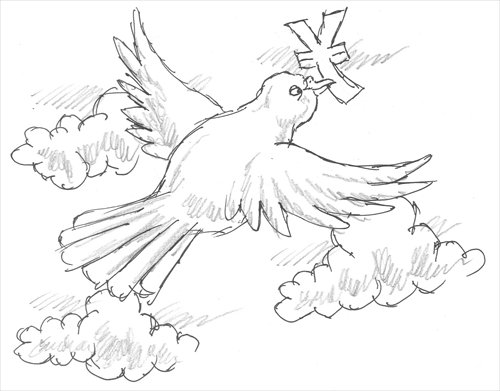HOME >> BUSINESS, OP-ED
What is the real situation in China’s economy?
By John Ross Source:Global Times Published: 2015-7-19 23:03:01
‘China collapse’ school of thought misguided

Illustration: Peter C. Espina/GT
China's announcement of 7 percent first-half GDP growth, in line with its whole year forecast, led to the inevitable questioning of the figures by the "China collapse" school of critics. US hedge fund manager Paul Singer declared that China faced a crisis "bigger than subprime [mortgages]" - the financial meltdown leading to the 2008 US "Great Recession." Others claimed China's first-half figures were fake, or recovery was due to factors such as share price increases - therefore China's performance would worsen in the second half of 2015. Examining why these arguments are false, as similar ones have habitually proved to be over decades, clarifies the real processes in China's economy.
Starting with the 7 percent figure, faking economic statistics is much harder than those not professionally dealing with them realize. First, outputs from one part of the economy are inputs to others. It is therefore impossible to simply falsify a single figure such as GDP. Experts would easily find data inconsistencies - as countries attempting this have found out! To significantly falsify such a general economic statistic as GDP, large amounts of other data would have to be simultaneously faked.
Second, such falsification would have to include many outside China. China's is the world's most open large economy - almost 60 percent of China's GDP is trade. For trade, more than one country holds data. Trends for 60 percent of China's economy can therefore be checked against other countries' statistics. US and China statistical studies, for example, found no major trade data discrepancies.
Third, some economic categories are much more easily calculated than others - output by a few thousand large industrial enterprises is more accurately measured than millions of small service companies. It is therefore particularly significant that China's June value added in industrial production rose to 6.8 percent, compared March's 5.6 percent low. As all studies agree that China's services in the first half of the year grew more rapidly than industry, growth of value added in services by June would be above 6.8 percent.
Therefore The Economist, a serious publication, unlike the "China is about to collapse" school, concluded under the self-explanatory headline "Whether to believe China's GDP figures" that: "The industrial sector grew 6.1 percent year-on-year in the first half… By contrast, the services sector jumped to 8.4 percent growth from 7.9 percent in the first quarter…. the gains for financial services… were real. China's statisticians did not invent them."
Goldman Sachs' former chief economist Gavyn Davies, in the Financial Times, noted the recovery in economic performance even before publication of the GDP figures. The Fulcrum "nowcast" model - one of the increasing numbers of economic analyses predicting current GDP based on correlations with the most up to date data - found: "Chinese activity has risen to 7.9 percent from the low point of 5 percent that was reached earlier in the year. This rebound has followed… the major shift toward reflation that occurred in macroeconomic policy in the second half of April."
Turning to arguments by serious commentators that China's economic performance will deteriorate in the second half of 2015, the main evidence cited to support this is recent share price falls. For example, The Economist's article fundamentally vindicating the 7 percent growth figure questioned "the sustainability of the services strength. It was predicated to a large extent on financial services benefiting from the stockmarket bubble that popped last month."
While this argument merits serious examination, as opposed to the "China will crash" brigade, it does not accurately understand China's macroeconomic structure. Shares are owned by only a small proportion of China's population and are a minor source of company funding - as shares are neither major sources of consumer income nor capital investment, recent price falls will therefore have no substantial direct macro-economic effects.
Nor will secondary effects from share prices have a major impact. In a Western capitalist economy, a substantial weakening of private banking would likely result from substantial share prices falls, probable financial companies' bankruptcies, or calls for margin payments on shares. Western measures such as canceling IPOs, if adopted by China, would therefore lead to companies having difficulty in accessing finance. But China has a much stronger macro-economic structure than the West, with State owned and supported banks - therefore there will be no comparable secondary macroeconomic effect. The negative effect of share price falls is consequently much less than the stimulus effects of interest rate cuts, reserve requirement ratio reductions, and infrastructure investment launched in the second quarter.
Unless a major policy mistake is made, China's rebound from the negative trend seen in the first quarter will continue. Consequently there is no reason to suppose China will not achieve its overall "around 7 percent" 2015 growth target. To give international comparisons, China's economic growth in 2015 will be more than twice as fast as that of the US and more than three times as fast as that of the EU or Japan.
The author is a senior fellow of the Chongyang Institute for Financial Studies at Renmin University of China, and former director of Economic and Business Policy for London. bizopinion@globaltimes.com.cn
Posted in: Expert assessment, Biz Comments